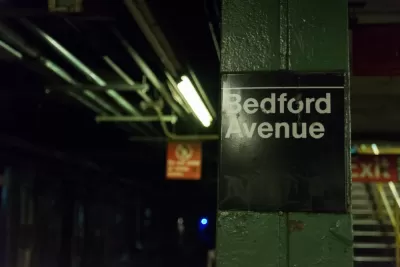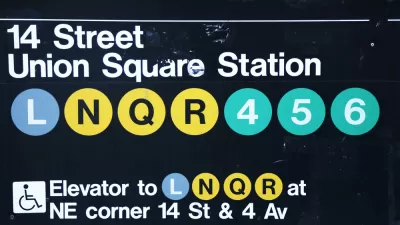The long awaited repair work on the L Train between Brooklyn and Manhattan launched over the weekend.

Ali Watkins and Edgar Sandoval report from the first weekend of a partial shutdown on the L Train on the New York MTA subway system.
"The crowds? Large, but not mutinous. The annoyance levels during the inaugural weekend of the L train slowdown? Present, but predictable."
The MTA is running significantly fewer trains on the L line on nights and weekend for the next 15 to 18 months to make repairs to damage caused by Hurricane Sandy. The partial shutdown is the work of Gov. Andrew Cuomo, who intervened at the 11the hour in a plan to shut down the line completely.
Now the long-awaited repair work has begun, and Watkins and Sandoval report that it all could have gone a lot worse on the first weekend. "Despite doomsday predictions of long turnstile lines, closed station entrances and dangerously crowded platforms, the L train’s first rehab weekend went as well as the Metropolitan Transportation Authority could have hoped."
At the time of their writing, the return to regular schedules for Monday rush hour was an open question, but Stephen Nessen and Jake Offenhartz picked up where Watkins and Sandoval left off.
"On Monday at 5 a.m, L train service was supposed to return to normal after the first weekend of construction, just in time for the morning rush hour. And it did—for an hour. Then at 6 a.m. an L train with mechanical issues caused delays that rippled to Bedford Avenue, where headways jumped from 9 minutes to 24 minutes."
Still, by 6:40 am, the trains were running on schedule again. New York City Transit President Andy Byford was on hand at the Bedford Avenue and was pleased with what he saw, according to the article. Nessen and Offenhartz offer their own assessment of the weekend slowdown too, and paint a slightly less rosy picture.
FULL STORY: L Train Slowdown: First Weekend Disruption Is Frustrating, but Not Disastrous

Alabama: Trump Terminates Settlements for Black Communities Harmed By Raw Sewage
Trump deemed the landmark civil rights agreement “illegal DEI and environmental justice policy.”

Planetizen Federal Action Tracker
A weekly monitor of how Trump’s orders and actions are impacting planners and planning in America.

The 120 Year Old Tiny Home Villages That Sheltered San Francisco’s Earthquake Refugees
More than a century ago, San Francisco mobilized to house thousands of residents displaced by the 1906 earthquake. Could their strategy offer a model for the present?

In Both Crashes and Crime, Public Transportation is Far Safer than Driving
Contrary to popular assumptions, public transportation has far lower crash and crime rates than automobile travel. For safer communities, improve and encourage transit travel.

Report: Zoning Reforms Should Complement Nashville’s Ambitious Transit Plan
Without reform, restrictive zoning codes will limit the impact of the city’s planned transit expansion and could exclude some of the residents who depend on transit the most.

Judge Orders Release of Frozen IRA, IIJA Funding
The decision is a victory for environmental groups who charged that freezing funds for critical infrastructure and disaster response programs caused “real and irreparable harm” to communities.
Urban Design for Planners 1: Software Tools
This six-course series explores essential urban design concepts using open source software and equips planners with the tools they need to participate fully in the urban design process.
Planning for Universal Design
Learn the tools for implementing Universal Design in planning regulations.
Clanton & Associates, Inc.
Jessamine County Fiscal Court
Institute for Housing and Urban Development Studies (IHS)
City of Grandview
Harvard GSD Executive Education
Toledo-Lucas County Plan Commissions
Salt Lake City
NYU Wagner Graduate School of Public Service





























